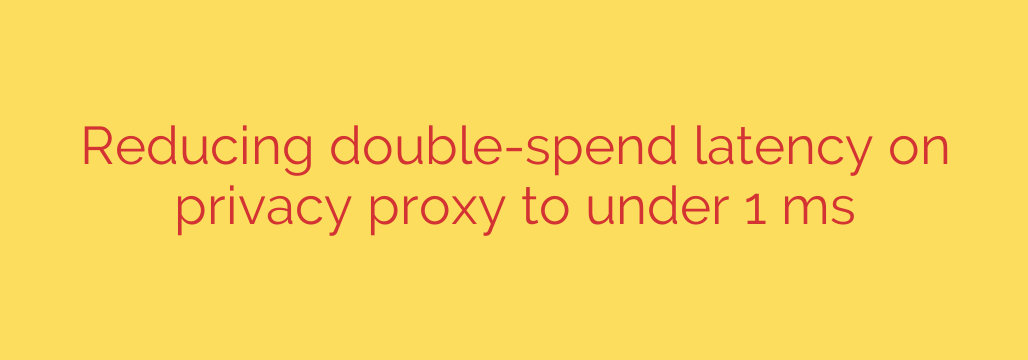
Fortifying Digital Payments: How to Stop Double-Spend Attacks in Under 1 Millisecond
The promise of private digital transactions is immense, offering users financial anonymity in an increasingly tracked world. However, this privacy comes with a critical security challenge: the double-spend attack. This is a form of fraud where a malicious actor spends the same digital funds twice before the system can register the first transaction, effectively stealing from merchants and undermining the integrity of the entire payment network.
For any privacy-preserving payment system to be viable for real-world use, from buying coffee to online shopping, it must be able to detect and block these attacks almost instantly. A few seconds, or even a few hundred milliseconds, is too long. Now, a groundbreaking new architecture has proven it’s possible to slash this detection time to less than a single millisecond, making real-time, private digital commerce a secure reality.
The Double-Spend Dilemma in Private Systems
In traditional finance, a central authority like a bank prevents double-spending. In decentralized or privacy-focused systems, this is more complex. To protect user privacy, the system can’t link a user’s identity directly to their transactions. Instead, it relies on cryptographic proofs.
When a user spends a digital token, they generate a unique cryptographic value called a “nullifier.” Think of a nullifier as a one-time-use digital receipt that proves a specific token has been spent, without revealing who spent it or where. To prevent fraud, the system maintains a massive database of all used nullifiers. Before approving a new transaction, it checks if its nullifier is already in the database. If it is, the transaction is a double-spend attempt and is immediately rejected.
The problem is speed. If this check takes too long, an attacker can broadcast two transactions with the same nullifier to different parts of the network. If the second transaction gets processed before the first one’s nullifier is recorded, the fraud succeeds. Previous systems often had a detection latency of over 100 milliseconds—far too slow for point-of-sale security.
The Blueprint for Sub-Millisecond Detection
Achieving sub-millisecond latency required a complete rethinking of the system’s architecture, focusing on eliminating bottlenecks and maximizing parallel processing. The solution rests on three core engineering principles.
1. A Shift to High-Speed, In-Memory Processing
The first and most significant change was moving the entire nullifier database from disk to system memory (RAM). Disk-based databases are inherently slow due to the physical time it takes to read and write data.
By holding the entire set of nullifiers in an in-memory concurrent hash map, the system can perform checks at the speed of RAM, which is orders of magnitude faster than disk. This instantly removes the primary performance bottleneck that plagued older designs. While this requires more memory, the dramatic increase in speed is essential for real-time security.
2. Intelligent Sharding for Massive Scalability
Even in memory, a single, monolithic database can become a chokepoint under heavy load. When thousands of requests arrive simultaneously, they can get stuck waiting in line to access the database.
To solve this, the architecture implements database sharding. The nullifier database is split into numerous smaller, independent partitions, or “shards.” Incoming requests are intelligently routed to the correct shard based on the nullifier’s value. This allows the system to process many requests in parallel, as a lock on one shard doesn’t block access to others. This design not only boosts speed but also ensures the system can scale to handle millions of users and hundreds of thousands of requests per second without slowing down.
3. Strategic Batching for Peak Efficiency
Processing every single request individually can be inefficient, as each one carries a small amount of overhead. To optimize performance under high-volume conditions, the system uses a smart batching strategy.
Incoming requests are briefly collected and then processed together in a single batch. This reduces the computational overhead per request and significantly improves throughput. The system is designed to handle this batching within a tight time window, ensuring it doesn’t add any noticeable latency while making the entire process far more efficient, especially during traffic spikes.
The Result: Redefining Real-Time Security
By combining these three strategies—in-memory storage, sharding, and batching—this new architecture achieves truly remarkable performance. Under a heavy load of 100,000 requests per second, the system successfully detects double-spend attempts with a p99 latency of just 700 microseconds (0.7 milliseconds).
This sub-millisecond speed is a game-changer. It means that for virtually any real-world transaction, a double-spend attempt can be identified and blocked before a fraudulent purchase can ever be completed. Merchants are protected, and users can confidently transact with both privacy and security. This breakthrough closes a critical vulnerability, paving the way for a future where fast, private, and secure digital payments are the standard.
Source: https://blog.cloudflare.com/reducing-double-spend-latency-from-40-ms-to-less-than-1-ms-on-privacy-proxy/








